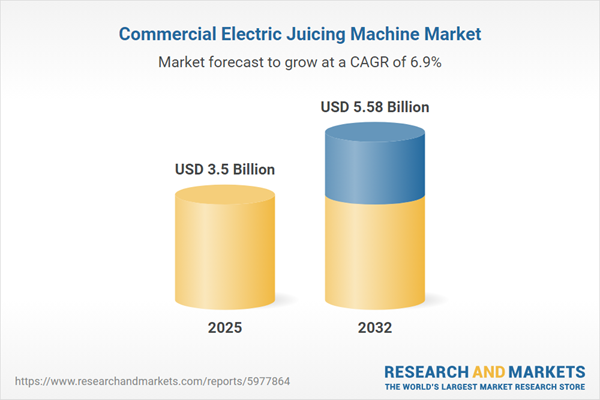Speak directly to the analyst to clarify any post sales queries you may have.
Senior decision-makers in foodservice, hospitality, and retail are leveraging commercial electric juicing machine technology to enhance operational efficiency, support evolving consumer health preferences, and address regulatory shifts. As this market segment grows, understanding equipment selection, value-driving innovations, and regional nuances becomes essential for sustained competitive advantage.
Market Snapshot: Commercial Electric Juicing Machine Market
The commercial electric juicing machine market grew from USD 3.28 billion in 2024 to USD 3.50 billion in 2025. It is forecast to continue expanding at a CAGR of 6.86%, reaching USD 5.58 billion by 2032. This growth underscores the continuing alignment of foodservice and retail operators with consumer demand for nutritious, freshly prepared beverages, supported by advancements in machine design and sustainable technology.
Scope & Segmentation
This analysis delivers actionable intelligence for executive leadership, procurement, and operations teams. It covers a complete breakdown of products, applications, regions, and leading players.
- Appliance Types: Centrifugal, Citrus, Masticating, Triturating
- Distribution Channels: Offline Stores, Online via Manufacturer Websites, Online through Third-Party Platforms
- Applications: Cafes and Restaurants, Educational Institutions (Schools, Universities), Healthcare Facilities (Clinics, Hospitals), Hotels and Resorts, Juice Bars and Smoothie Shops
- Power Ratings: Below 1000 Watt, 1000 to 1500 Watt, Above 1500 Watt
- Operation Modes: Automatic, Semi-Automatic
- Regions: Americas (United States, Canada, Mexico, Brazil, Argentina, Chile, Colombia, Peru), Europe, Middle East & Africa (including United Kingdom, Germany, France, Russia, Italy, Spain, Netherlands, Sweden, Poland, Switzerland, UAE, Saudi Arabia, Qatar, Turkey, Israel, South Africa, Nigeria, Egypt, Kenya), Asia-Pacific (China, India, Japan, Australia, South Korea, Indonesia, Thailand, Malaysia, Singapore, Taiwan)
- Major Companies: Zumex Group, S.A.; Santos SAS; Robot Coupe SAS; Conair Corporation; Hamilton Beach Brands Holding Company, Inc.; Sirman S.p.A.; BUNN-O-MATIC CORPORATION; Angel Products Co., Ltd.; Kuvings Co., Ltd.; Hurom Co., Ltd.
Key Insights & Strategic Takeaways
- Innovative integration of energy-efficient motors and automated cleaning cycles is reducing utility costs and operational downtime for high-throughput environments.
- Growing demand for customizable and modular equipment is driving the shift toward user-configurable components, supporting a diverse range of juice blends and produce types in commercial settings.
- Sustainability requirements, including recyclable materials and low-noise operations, are influencing product design and procurement strategies across regions.
- Smart sensors and IoT-enabled diagnostics enable real-time performance monitoring and predictive maintenance, minimizing service disruptions and extending equipment lifecycles.
- Service-based revenue streams, such as extended warranties and replacement part packages, are becoming core elements of manufacturer differentiation and customer retention.
- Regional demands vary: North American and European markets prioritize efficiency and eco-certifications, Latin American and Asia-Pacific buyers focus on cost-effectiveness, compact design, and rapid customization.
Tariff Impact and Adaptive Strategies
Recent trade tariffs have raised supply chain costs for commercial electric juicing equipment, prompting a movement toward near-shoring production and sourcing local subassemblies. Manufacturers and operators are revising procurement agreements, extending equipment lifespans, and investing in modular upgrade capabilities. These adaptive strategies help safeguard business continuity and preserve competitive pricing amid regulatory uncertainties.
Methodology & Data Sources
This report utilizes a comprehensive research approach, combining extensive secondary analysis of industry literature, regulatory filings, and proprietary databases with in-depth primary interviews of engineers, procurement leaders, and facility managers. Data validation involved peer review and cross-checking quantitative metrics against qualitative insights for a complete market perspective.
Why This Report Matters
- Guides senior decision-makers in selecting scalable, maintenance-friendly commercial electric juicing technology tailored to diverse business models.
- Delivers actionable regional and segment-specific insights for aligning investments with evolving consumer, regulatory, and sustainability trends.
- Equips procurement leaders with strategies to adapt to supply chain disruptions, shifting policies, and emerging technology standards.
Conclusion
Industry stakeholders who invest in modular, efficient, and data-enabled commercial electric juicing solutions will be positioned to meet shifting market expectations. Aligned strategy, agile supply chains, and robust service offerings are central to long-term success in this evolving sector.
Additional Product Information:
- Purchase of this report includes 1 year online access with quarterly updates.
- This report can be updated on request. Please contact our Customer Experience team using the Ask a Question widget on our website.
Table of Contents
3. Executive Summary
4. Market Overview
7. Cumulative Impact of Artificial Intelligence 2025
Companies Mentioned
The companies profiled in this Commercial Electric Juicing Machine market report include:- Zumex Group, S.A.
- Santos SAS
- Robot Coupe SAS
- Conair Corporation
- Hamilton Beach Brands Holding Company, Inc.
- Sirman S.p.A.
- BUNN-O-MATIC CORPORATION
- Angel Products Co., Ltd.
- Kuvings Co., Ltd.
- Hurom Co., Ltd.
Table Information
| Report Attribute | Details |
|---|---|
| No. of Pages | 185 |
| Published | October 2025 |
| Forecast Period | 2025 - 2032 |
| Estimated Market Value ( USD | $ 3.5 Billion |
| Forecasted Market Value ( USD | $ 5.58 Billion |
| Compound Annual Growth Rate | 6.8% |
| Regions Covered | Global |
| No. of Companies Mentioned | 11 |









